Deductions of earnings order: An employer’s guide to child maintenance
Published
Deductions of earnings order: An employer’s guide to child maintenance
Published
Receiving a Deduction of Earnings Order (DEO) can seem a little daunting at first. It’s an official notice from the Child Maintenance Service (CMS), asking you to deduct money from an employee’s wages to support a child. Suddenly, payroll might seem more complicated than usual and it’s natural to double-check every calculation to make sure you’re doing it right.
The good news is that managing a DEO is far simpler than it sounds. Your role as an employer is mainly administrative; you’re helping ensure payments are collected accurately and on time.
In this guide, we’ll walk you through everything you need to know. You’ll learn how DEOs work, how to calculate deductions correctly and how Employment Hero’s payroll software can help you stay compliant while keeping the process simple and stress-free.
For a more in-depth look at all the intricacies involving DEO’s, download our ‘Deduction of Earnings Order: The Complete Guide for Employers.
What is a deduction of earnings order?
A Deduction of Earnings Order is a legal instruction from the CMS that tells employers to deduct child maintenance from an employee’s pay or pension. The money is then passed to CMS, who sends it to the receiving parent. This system helps ensure payments are consistent and reach the child they are intended to support.
DEOs are issued in situations such as when a parent is behind on payments, owes arrears, or agrees to have maintenance deducted automatically from their earnings.
It’s important to understand the difference between a DEO and an Attachment of Earnings Order (AEO). While both involve deductions from wages, AEOs are court-issued for debts like fines, taxes, or other financial penalties. DEOs, on the other hand, are specific to child maintenance and take priority over most other deductions.
When a DEO arrives, it’s a high-priority instruction. Acting promptly helps you stay compliant and ensures the employee meets their obligations without unnecessary delays.
How does a deduction of earnings order work in payroll?
Handling a DEO might seem complicated at first, but it’s mostly a straightforward process once you know the steps. Here’s how to do it:
Step 1: Review the DEO notice
When CMS sends a DEO, read it carefully. It will tell you which employee it applies to, how much to deduct, how often the deductions need to be made and the reference you must include when sending payments.
Step 2: Calculate net earnings
Determine the employee’s net pay for the period. This is the amount remaining after tax, National Insurance and any other statutory deductions.
Step 3: Apply the Protected Earnings Proportion (PEP)
The law requires employees to keep at least 60% of their net pay. This is called the Protected Earnings Proportion. Only the amount above this 60% can be deducted for child maintenance.
Step 4: Determine the deduction amount
Compare the DEO amount to the available margin above the protected earnings. If the DEO is less than or equal to the margin, deduct it in full. If it is higher, deduct as much as possible and carry the remaining balance forward to the next pay period.
Step 5: Include optional administration fee
Employers can deduct an extra £1 per pay period to cover administrative costs. Make sure this does not reduce the employee’s pay below the protected earnings threshold or the National Minimum Wage.
Step 6: Process the deduction in payroll
Apply the deduction during the employee’s pay run, either manually or using payroll software. Ensure the correct reference number from the DEO is included.
Step 7: Send the payment to CMS
Transfer the deducted amount to CMS promptly. Payments must reach them by the 19th of the month following the pay period.
Step 8: Keep records
Document all deductions, any shortfalls carried forward and all communications with CMS. Accurate records protect you in case of queries or audits.
Step 9: Notify CMS of changes
If an employee leaves, their pay changes significantly, or you cannot make the full deduction, inform CMS immediately. This keeps you compliant and ensures the child continues to receive payments.
How DEO deductions are calculated
To see how deductions work in practice, let’s look at a simple example. If an employee’s net pay is £1,200 per month, 60% of that (£720) must remain as protected earnings. That leaves £480 available for deduction. If the DEO instructs you to deduct £400, you can take the full amount and leave the employee with £1,100.
If the DEO amount is £500, you can only deduct £480 in that pay period. The remaining £20 will carry forward to the next pay run.
DEOs take priority over most other deductions. If an employee has multiple orders, priority orders are applied first in the order they were received. Non-priority orders follow afterwards. This ensures child maintenance is treated as a top priority.
How to process DEOs in Employment Hero’s payroll software
Managing DEOs manually can be stressful, especially with multiple employees or orders to track. Employment Hero’s payroll software is designed to make this process simple and error-free.
With Employment Hero, you can set up a DEO once and the system will automatically apply the correct deductions every pay run. It calculates the protected earnings proportion, tracks shortfalls and ensures priority rules are followed.
Payslips are clear and transparent, showing employees exactly what has been deducted and why. The software also maintains an audit trail of all deductions and payments, making compliance checks and reporting straightforward.
By automating these tasks, your payroll team saves time and reduces the risk of mistakes. It also gives employees confidence that their pay is being handled correctly.
What compliance rules must employers follow?
Processing DEOs comes with legal responsibilities. Timely and accurate deductions are essential to avoid penalties. Deductions should begin as soon as possible after receiving the order and payments must reach CMS by the 19th of the following month.
If you can’t make a full deduction, or if an employee leaves, you must notify CMS immediately. Failure to comply can lead to fines of up to £500 per missed deduction and up to £1,000 for failing to provide required information.
You also need to keep detailed records of each deduction, amounts carried forward and any communications with CMS or the employee. Payslips should clearly show deductions and the reason for them. Clear documentation protects you and helps employees understand their pay. For guidance on payslips, check out our payslips explained guide and payslip abbreviations guide.
What are employees’ rights under a DEO?
Employees subject to a DEO have rights you must respect. They should receive clear notice of the deduction, including any administration costs. Many employers include this information on the payslip, which is acceptable as long as it is clear.
Protected earnings ensure the employee keeps at least 60% of net pay. They cannot be reduced below the National Minimum Wage, even with the optional £1 administration fee.
Employees can also query deductions if they believe an error has been made. They may raise concerns internally with HR or contact CMS directly. Promptly addressing questions helps prevent disputes and ensures transparency.
What happens if an employee leaves your business with an active DEO?
If an employee with a live DEO leaves your business, you still have responsibilities. Notify CMS immediately, provide the employee’s final pay date and stop making deductions beyond that date.
CMS may issue a new DEO to the employee’s next employer and your duty ends once the CMS is properly notified. It’s also important to keep records of all deductions for future reference, particularly if CMS requests verification or an audit.
For guidance on handling payroll when employees leave, see our guide on the end-of-employment payroll process.
Stay compliant and confident with DEOs
Managing a DEO doesn’t need to be stressful. Understanding how deductions are calculated, staying on top of compliance and keeping clear records can make the process straightforward.
Employment Hero’s payroll software takes the guesswork out of DEOs. It automates calculations, applies the correct priority rules and keeps both you and your employees informed.
For a detailed checklist, templates and practical tips, download our full payroll guide and simplify how you manage DEOs and payroll every month.
To download the guide, we just need a few quick details.
Related Resources
-
 Read more: How to Create Bespoke E-Inductions For New Hires And Contractors
Read more: How to Create Bespoke E-Inductions For New Hires And ContractorsHow to Create Bespoke E-Inductions For New Hires And Contractors
Learn how to design bespoke e-inductions for new hires and contractors. Discover flexible, learner-centred solutions to improve onboarding and retention.
-
 Read more: Power Your Accounting Firm with Employment Hero
Read more: Power Your Accounting Firm with Employment HeroPower Your Accounting Firm with Employment Hero
Join the Employment Hero Accounting Partner Programme. Earn commission, access exclusive support and help SMEs simplify HR and payroll management.
-
 Read more: Grief at work: A leader’s guide to supporting employees
Read more: Grief at work: A leader’s guide to supporting employeesGrief at work: A leader’s guide to supporting employees
Learn how to support grieving employees and create a compassionate workplace. Discover what to say, what to avoid, and how…



















